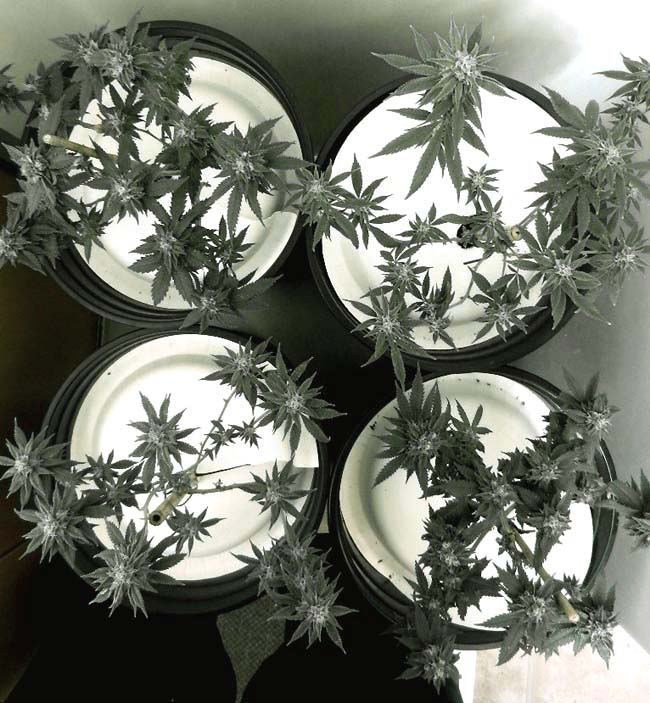Bubba Kush flowers at 23 days. Many new pistils in just the last couple
of days as the flowers start to build and stack their calyxes (ovaries) -
there are two pistils per calyx which are the external pollen receptors.
In this image you can see the results of training a branch to grow horizontally
for a period of time so the buds further down are given a chance at equal
development. Here there are 3 flowers on the horizontal and 3 more on the
vertical stalk of the same branch. A number of the larger fan leaves have
been removed in order to highlight the structure of the branch which begins
horizontally at the lower right hand corner and terminates in a vertical
position.
Already giving some thought to this season's harvest. Read about one grower
who just leaves his plants in their containers unwatered in a dark but ventilated
room where they dry 'on the stalk' so to speak. Thinking I might divide the
various harvests in two sections - one plant left in its pot and the other
cut down and hung. Both sets can be dried in the flowering chamber which
has adequate ventilation and filtered exhaust and won't be used again until
next year.
9-25: Relocated the large Holy Grail Kush plant back to the (modified) vegetation
chamber to give all the plants more room and light.
September 27th: Week 5 (Flowering)
Raised the shelf in this
chamber bringing all its plants to within 5 inches of the overhead light which
is the recommended
minimum distance.
The amount of light intensity is 50,420 foot candles or 27,500 lumens. If
you make comparisons on the chart you will see that 50,000 foot candles is
just 15,000 fewer than any of the larger wattage HPS bulbs at their recommended
distance. Basically this is as good as it gets given the space and heat considerations.
With an eye on the increasing electrical costs I have been experimenting with
leaving the exhaust fan off until the outside temperatures warm up around
noon. This cuts its energy drain in half without raising the chamber temps
beyond the low 80's. Currently the plant odor is not yet noticeable and so
it is safe to leave it off. In another couple of weeks that may not be the
case. Also relocated its collector hood to the back side of the overhead
light increasing its extraction efficiency.
9-29:
Here
is an image of the developing calyxes and pistils - notice that about 50%
of the pistils have begun to mature and darken which is a sign of their approaching
maturity. The trichomes are still quite immature though and appear as a light
dusting on the flowers and leaves.
9-30:
Bubba Kush: foreground left and rear right
Found this article on the advisability of
removing most of the fan leaf
after the 4th week of flowering on Kush strains. The claim is that the plant
no longer needs them and they would have dropped off in nature by that time.
Retaining them only drains nutrients better directed towards building flowers
than leaf at that stage. The plant's nutrient needs can be met by the fully
developed root system unlike a plant still in the vegetative stage.
Accordingly
all the current plants, being Kushes, were
"stripped to sticks with just a few fan leaves, but with all of the budding sites intact"
as the article suggests. Added inverted paper plates as container covers
to help retain soil moisture and reflect light up to underside of plants.

Here is a enhanced (Photoshop) image emphasizing the more
exposed floral clusters resulting from the recent defoliation as seen from
the overhead light.
October 4th: Week 6 (Flowering)
Currently in the middle of a heat wave with outside temperatures in the
80's to 90's through the weekend. Shifted all plants to the vegetation chamber
and installed the A/C in the flowering chamber using the exhaust fan to vent
the extra heat. Since the two chambers are on opposite sides of a common hallway the doors between
them are left open during the day making, in effect, one contiguous chamber.
10:00 am: Inside grow room temps over 86 already and the
A/C can no longer could keep up. All plants moved to the front of the coach
under the surround windows and overhead fan which is just as acceptable and
quite a bit more energy efficient.
With another fan and the outside door open plus a little cross ventilation
the temps are 84F. This is their first exposure to direct
sunlight ... will have to get a good light meter to see if the lumination
equals that of the grow chambers.
Certainly there is enough light to carry
the plants through the next couple of days.
October 11th: Week 7 (Flowering)
I was wondering why the flowering chamber heated up so fast even
though the exhaust fan is 190 CFM (cubic feet per minute). Since the entire
chamber is only 24 cubic feet the air supply should be refreshed at least
7 times per minute.
Reread the instructions and realized the carbon filter had been installed
incorrectly. The filter is supposed to be in the chamber with the exhaust
fan mounted downstream pulling air through it and venting outside the chamber.
I had mounted both externally with the fan pushing the extracted air through
the filter instead. The extra load on the fan reduced its efficiency and
resulted in the heat build up.
Relocated the filter to the top of the flowering chamber in line with the
vent opening suspended by bailing wire from the ceiling.
Before the next grow I will attach a vent tube to the outlet side of
the external exhaust fan and route all the extracted heat out through
the roof so that will be removed from both the chamber and the coach.
For the time being it vents near the ceiling in the rear bedroom and is removed
by that room's 14" overhead fan.